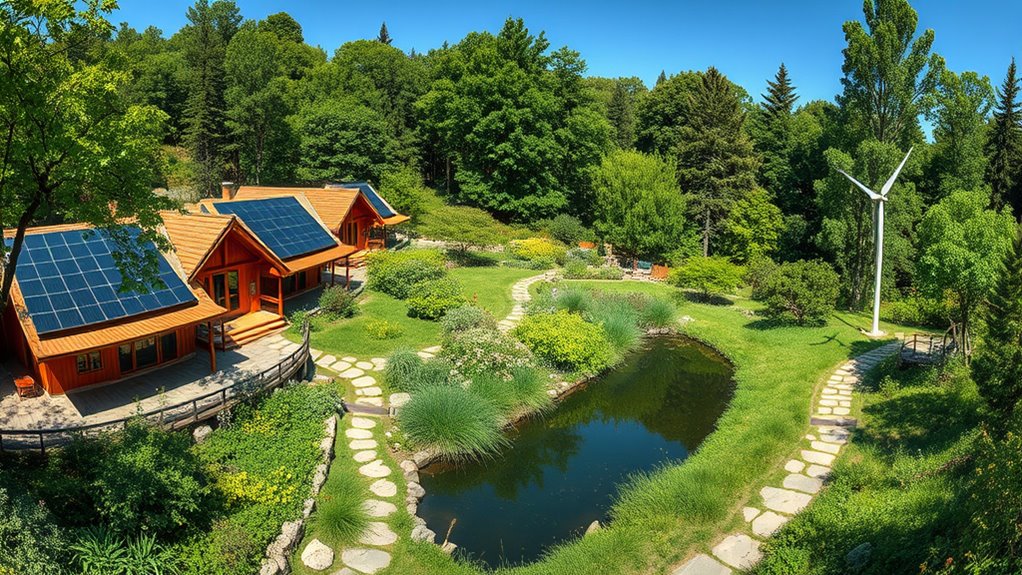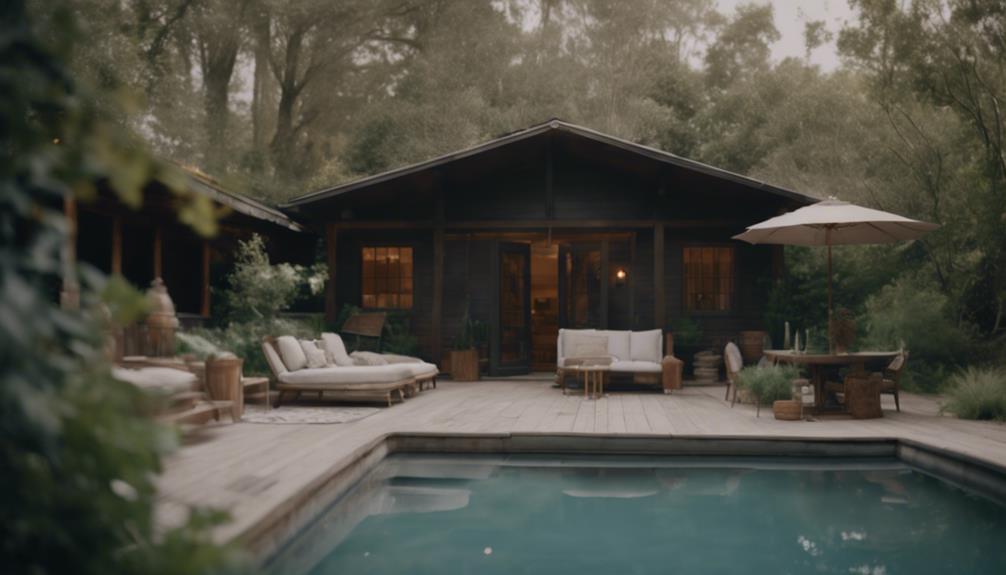To create an eco-friendly retreat from start to finish, you should pick a sustainable location with abundant sunlight or wind to harness renewable energy. Design your space using natural materials and passive techniques, and incorporate eco-friendly fixtures. Engage in responsible activities, such as conservation projects and wildlife habitats, while supporting local communities through local hiring and crafts. Practice eco-conscious habits during your stay. Keep exploring to discover more ways to make your retreat truly sustainable.
Key Takeaways
- Select locations with abundant renewable energy resources and proximity to infrastructure to minimize environmental impact.
- Design accommodations using natural, eco-friendly materials and passive strategies to reduce energy and water consumption.
- Incorporate conservation initiatives like wildlife habitats and eco-friendly activities that promote awareness and protect local ecosystems.
- Support local communities through job creation, sourcing indigenous crafts, and engaging in community-led initiatives.
- Promote eco-conscious habits such as resource conservation, supporting local vendors, and offsetting carbon emissions.
Choosing a Sustainable Location

Have you considered how the location of your retreat impacts its environmental footprint? Choosing a site that promotes renewable energy use can considerably lower your retreat’s carbon emissions. Look for locations with abundant sunlight or wind, making solar panels or wind turbines viable options. These energy sources help power your retreat sustainably. Additionally, selecting a site near existing infrastructure reduces transportation emissions and supports waste reduction by minimizing the need for extensive construction or resource transportation. Opt for areas that prioritize conservation efforts and have a low impact on local ecosystems. By carefully selecting a sustainable location, you set a strong foundation for your eco-friendly retreat, ensuring minimal environmental disruption while maximizing the potential for renewable energy integration and waste reduction.
Eco-Friendly Accommodations and Design

Building on your sustainable site choice, designing eco-friendly accommodations is key to minimizing your retreat’s environmental impact. Focus on green building principles, such as using natural materials and maximizing insulation to reduce energy use. Incorporate renewable energy sources like solar panels or wind turbines to power your facilities sustainably. Consider passive design strategies, like proper orientation and natural ventilation, to lower energy needs. Use water-saving fixtures and waste management systems to reduce your footprint. Integrate eco-friendly furnishings and finishes to ensure every detail aligns with your sustainability goals. By prioritizing green building techniques and renewable energy, you create a retreat that’s both environmentally responsible and inviting for guests committed to eco-conscious travel. Additionally, selecting a top beach location can enhance the natural appeal and ecological harmony of your retreat.
Responsible Activities and Conservation Initiatives
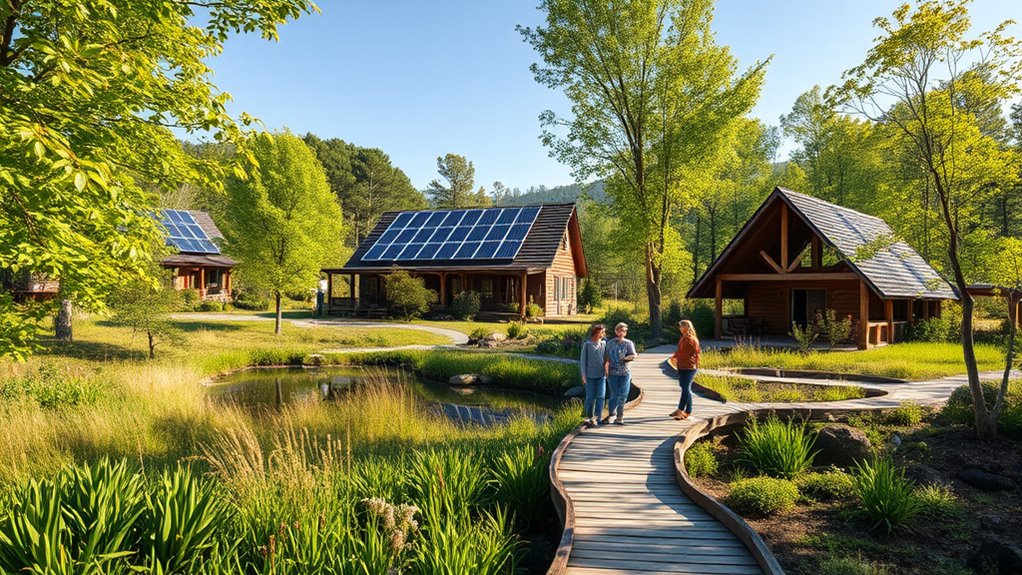
To truly minimize your retreat’s environmental impact, you need to prioritize responsible activities and conservation initiatives. Focus on wildlife preservation by creating habitats that support local flora and fauna, avoiding disruptive activities. Encourage guests to participate in guided nature walks or conservation projects that promote awareness and stewardship. Implement renewable energy sources like solar or wind power to reduce reliance on fossil fuels, lowering your carbon footprint. Offer eco-friendly activities that respect the environment, such as kayaking instead of motor boating or hiking instead of ATV rides. Educate guests on conservation efforts and the importance of protecting local ecosystems. Incorporating glycolic acid in skincare routines demonstrates how sustainable formulations can improve skin health with minimal environmental impact. By integrating wildlife preservation practices and renewable energy, your retreat actively contributes to sustainability and encourages visitors to adopt responsible behaviors.
Supporting Local Communities and Economies
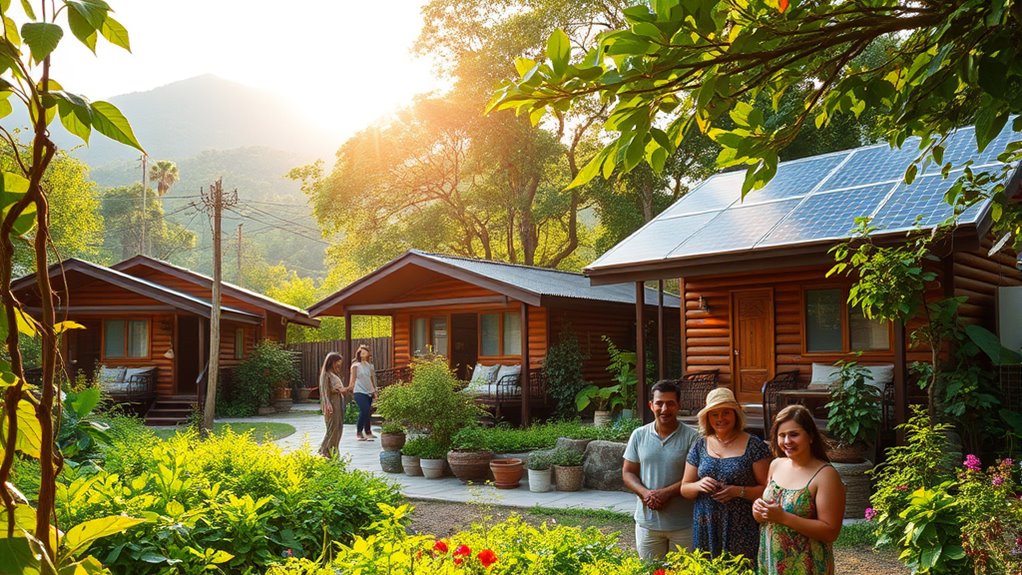
Supporting local communities and economies is essential for creating a sustainable retreat experience that benefits everyone involved. By prioritizing local job creation, you help ensure that the community thrives alongside your visit. Embracing indigenous crafts not only preserves cultural heritage but also provides economic support to artisans. You can contribute by:
- Hiring local guides and staff
- Purchasing handmade indigenous crafts
- Promoting local food and produce
- Supporting community-led initiatives
- Encouraging visitors to engage with local traditions
- Verifying the authenticity and ethical sourcing of products to ensure fair compensation for artisans and sustainability practices research companies thoroughly.
These actions foster a genuine connection to the area, empowering communities and ensuring your retreat leaves a positive impact. When you invest in local economies, you help build a more sustainable and equitable tourism model that respects and sustains the environment and culture alike.
Tips for Maintaining Eco-Conscious Travel Habits
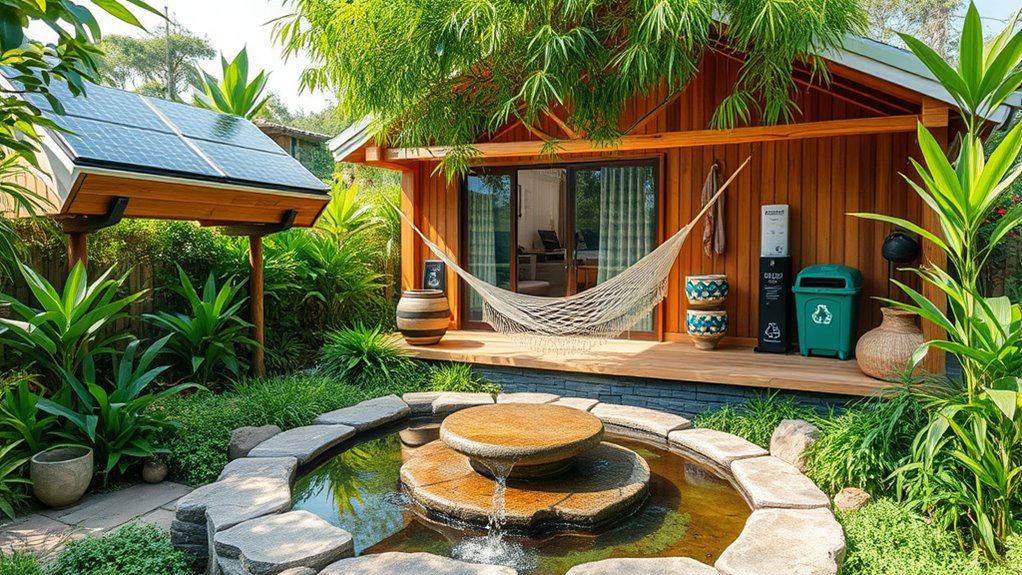
Maintaining eco-conscious travel habits requires intentional effort and mindfulness throughout your journey. To stay aligned with green travel principles, choose accommodations with eco certifications that verify their sustainability efforts. Be conscious of your resource use by turning off lights, reusing towels, and conserving water. Support local businesses to lessen your environmental footprint and enrich the community. Here’s a quick guide to help you stay on track:
| Action | Tip | Benefit |
|---|---|---|
| Choose eco-certified stays | Look for eco certifications like LEED or Green Key | Ensures sustainable practices are in place |
| Minimize waste | Use refillable bottles and bags | Reduces plastic waste |
| Respect local environments | Stick to marked trails and avoid disturbing wildlife | Preserves natural habitats |
| Support local vendors | Buy local crafts and produce | Boosts local economy |
| Offset your carbon footprint | Invest in carbon offset programs | Compensates for travel emissions |
Additionally, being mindful of sustainable design principles can enhance your eco-friendly travel experience by encouraging responsible choices in accommodations and activities.
Frequently Asked Questions
How Do Eco-Retreats Measure Their Environmental Impact?
You can measure your eco-retreat’s environmental impact by tracking its carbon footprint, which includes emissions from energy use and transportation. You also focus on resource conservation efforts like water-saving systems and waste reduction. Regular assessments help you identify areas for improvement, ensuring your retreat stays eco-friendly. Using tools like sustainability audits and monitoring energy consumption makes it easier to see how well you’re minimizing environmental effects.
What Certifications Indicate True Sustainability in Eco-Friendly Retreats?
You want to identify true sustainability, so look for eco labels that emphasize authenticity and meet strict certification standards. Certifications like LEED, Green Globe, or EarthCheck ensure the retreat adheres to rigorous environmental practices. These labels help you verify that the retreat genuinely minimizes its ecological footprint, avoids greenwashing, and commits to ongoing sustainability efforts. Trusting these recognized standards guarantees you’re supporting genuinely eco-friendly accommodations.
Are Eco-Retreats Suitable for Travelers With Disabilities?
You might wonder if eco-retreats are suitable for travelers with disabilities. Accessibility challenges can vary, but many eco-retreats now prioritize universal design to accommodate all guests. Look for retreats that clearly state their accessibility features, such as ramps or adapted facilities. By choosing places committed to inclusive experiences, you can enjoy a sustainable getaway that respects your needs and minimizes environmental impact.
How Do Retreats Ensure Local Cultural Preservation?
Imagine a vibrant tapestry, each thread representing local culture. You see retreats preserve culture through active community involvement and meaningful cultural exchange. They partner with local artisans, support traditional practices, and educate guests about heritage. By honoring customs and empowering local voices, retreats guarantee the cultural fabric remains strong. Your participation fosters respect and understanding, helping to weave a future where tradition and tourism thrive side by side.
Can Eco-Retreats Accommodate Dietary Restrictions Sustainably?
You can see that eco-retreats can accommodate dietary restrictions sustainably by offering plant-based options that reduce environmental impact. They prioritize ingredient sourcing from local, sustainable farms, which supports the community and minimizes carbon footprints. By carefully selecting ingredients and providing diverse, allergy-friendly menus, eco-retreats guarantee guests’ dietary needs are met without compromising their commitment to sustainability. This approach promotes both health and environmental responsibility.
Conclusion
Imagine yourself strolling through lush, green landscapes, feeling the warm sun on your skin and hearing the gentle rustle of leaves. By choosing eco-friendly retreats, you become part of a vibrant, thriving ecosystem that values sustainability from start to finish. Your mindful travel creates ripples of positive change, nurturing local communities and preserving natural beauty for future adventures. Together, you and these retreats help keep our planet lush, alive, and full of wonder.
